
About the Apiary
An informative and sometimes humorous column published in
The New Zealand Beekeeper Journal
READYING HIVES FOR WINTER
About the Apiary - April - 2018It’s April, and hopefully the robbing season has finished. Autumn has arrived. The willow leaves are turning yellow and as I write this, a southerly storm has dropped the temperature from a hot, sweaty 25°C to 14.1°C. The bees have been all over pennyroyal and are bringing in lots of pollen.
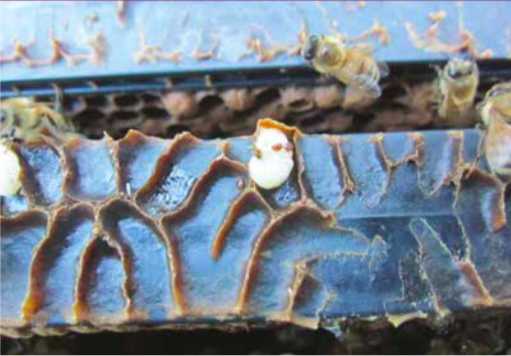
I have had a couple of good feeds of field mushrooms and collected half a sack of apples from a tree growing wild near one of my hives. The bees did a good job pollinating and the apples will be bottled so we can use them later in pies and on our porridge in the morning. Pity the weather was poor during the peach flowering: only three peaches on each tree this year instead of a boxful.
I suspect the drones will be tossed out shortly. You can delay their demise if you are doing some late queen rearing and want a particular hive’s genes by adding a bottle feeder to the hive with just a few holes. While there is nectar coming into the hive, the drones will not be ejected. The same feeding technique is used for banking queens over the winter.
A couple of weeks after the robbing season is over, the brood frames should be checked on a warm day for signs of disease. Flick off the cappings from 20 or so capped cells among the emerging brood and check the condition of the larvae underneath. Hopefully all will be well but our bees are scavengers and will rob a weak hive within three kilometres, so if there has been AFB in the area, check your hives carefully.
Monitoring for mites
What are the mite levels in your hives? You can get an indication you have mites if the bees have built drone cells in the brace comb between the boxes. As you break the boxes, the exposed drone pupae will tell you whether you have mites or not. If you haven’t already treated, there could be as many as two or three mites on each drone larva.
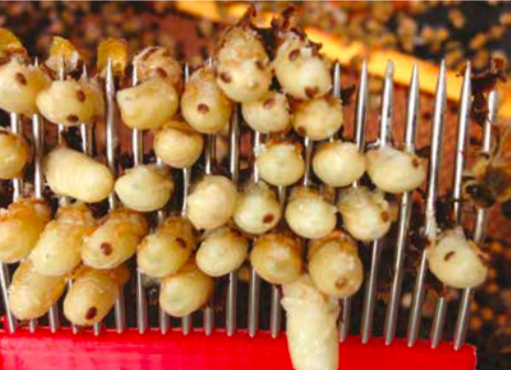
Another quick way to check is to slide a capping fork into drone larvae at the pink-eye stage (these come out whole). In some of my hives, the queen has moved right up to the top honey box and laid in thTo get a real idea of your mite infestation, do an alcohol mite wash using 300 bees off an open brood frame. Phoretic mites gather on the nurse bees, ready to hop off them and go into the cell when it’s about to be capped, so this is the frame from which you take a nurse bee sample.e drone cells there. Use a capping fork to remove the drone pupae and check for mites. Often there’s no sign of mites in the drone brood where you placed the strips but up top and away from the strips, it might be another story. Fork out all the drone cells anyway, as the bees will not leave brood if you use bee escape boards. Besides, all honey frames must be free of all brood and pollen before the honey can be extracted. Dead or dying brood can add CFUs to your honey.
“In microbiology, a colony-forming unit (CFU, cfu, Cfu) is a unit used to estimate the number of viable bacteria or fungal cells in a sample.” (Thanks, Google). The risk of adding CFUs is the reason why we don’t put honey supers on the ground or on to a dirty truck deck (they are put on clean drip trays and covered or shrink-wrapped to stop dust getting into them during transporting), and why we clean our hands excessively and our extracting plants at the end of each day.
Shake all the bees off the selected frame into the roof of the hive. The field bees will fly off, leaving the nurse bees. Check that the queen is not running around amongst the nurse bees in the roof. If she’s not there, shake the bees into a corner and scoop out half a cup and put them into your alcohol-filled mite washer. The remainder go back into the hive.
Screw on the lid and then leave the jar to stand for a minute or two so the mites begin to release from the bees. Swirl the container and give it the odd up-and-down shake to move the bees around. After a minute, if you have a double-jar model, turn it over while continuing to swirl the bees and the mites should accumulate in the bottom of the jar. With 300 bees in the washer, every three mites represent a one percent infestation.
Did the varroa treatment work? Your hives should have a varroa level below one percent. If it’s still a little high, repeat the treatment. You can also try another product and check again in two weeks to see if it’s working, or monitor the slide under the mesh bottom board if you use them. We want relatively varroa-free colonies going into winter.
Robbing
I made a mistake during the requeening of some queenless colonies later in February. I added a frame of emerging bees to boost bee numbers and popped in the shipping cage, reduced the entrances and kept an eye on the hives for the next couple of days.
The bees were flying well and bringing in pollen, so four days later in the evening, I went and released the cap on the queen cage so the queens could emerge from the cages through the candy. Two days later the colonies were being robbed out. That disturbance was enough to excite the bees in the other hives in the apiary and they overpowered these small colonies. Normally I would have used push-in cages to do this operation, then go back and release the queen from under the cage when she was laying, but I had left the toolbox that carries all the extra gear at home (I had been moving hives and wanted a clear deck on the truck), so opted just to use the shipping cage as an introduction cage.
Had I used the push-in cages, I would still have had a confined queen and a few bees looking after her. Instead, she was on the floor with all the other bees in the colony. Another lesson to remember next year when I’m requeening during the autumn robbing season. (Use push-in screens and robbing screens on small colonies and make some more robbing screens as well.)
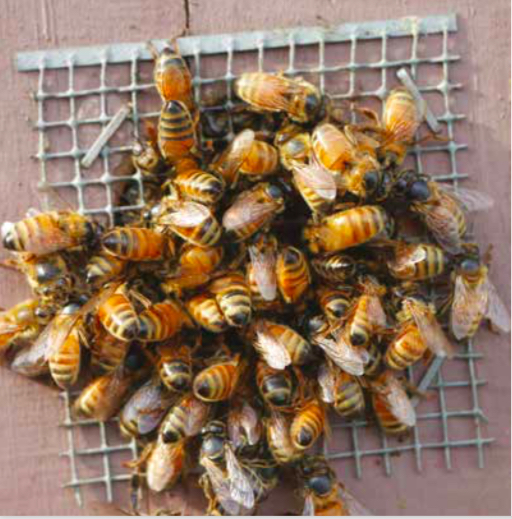
During March my bees chewed through a lot of their honey reserves and produced new bees. Several beekeepers had commented to me that their bees were small, and so were mine in some apiaries. These bees were produced toward the end of the drought when there was very little pollen, so naturally they were going to be small unless they were fed a pollen supplement.
Next time you inspect a hive, look at the newly hatched larvae. If they are not floating in royal jelly and if there’s very little stored pollen around the brood nest, feed a pollen supplement so the bees have adequate nutrition to feed their larvae. Some of those selling pollen supplements are recommending that colonies at this time of year are fed supplements to boost winter bees’ fat and mineral reserves.
With strips and formic acid flash pads in my hives and varroa under control (for the moment), and lots of pollen coming in, the next generation of bees should be a lot bigger and healthier.
Assessing winter stores and colonies
It’s been a funny season. Some hives have hardly any stored pollen and others have huge amounts. One hive I recently inspected had three three-quarter-depth boxes of pollen below the brood nest. I don’t use queen excluders and so with the dribble of nectar this year, the bees moved up and up, mostly storing pollen, but they also brought in two boxes of honey. Some who used queen excluders this year found there wasn’t enough nectar coming in to force the bees to store it above the queen excluder, so the bees just packed out the brood super. I also saw this with the foundation frames I put in. Most weren’t touched but the bees stored nectar in fully drawn comb.
Rather than lose the value of the pollen frames (i.e., the bees will cluster well above the pollen and it will go mouldy), I split the hive in half, adding the box of pollen to the box containing the new split. Note: the split had the old queen, six frames of brood, honey and bees which filled the whole box.
Apart from assessing your hives’ winter honey stores, it’s time to assess your colonies to see if they are strong enough and have enough young bees and food to take them through the winter. I produced a number of nuc hives this season and quite a few didn’t build as expected. I suspect it was poor nutrition and overstocking of hives, which meant that any available pollen and nectar were quickly used by stronger hives.
These hives are now building but are still fairly small. When it gets really cold, they will cluster into a tight ball but will perhaps cover only three or four frames. They are too small to control their environment in the full-depth super. The solution is to put them into a small box so they completely fill the box with bees.
An alternative is to use dummy boards. The English beekeepers used these to enclose the brood nest of small colonies and Brother Adam (Karl Kehrle, a Benedictine monk, beekeeper and bee breeder at Buckfast Abbey, England) used them in his mating nucs. The modern variation of this method is being used by primary students at Hukerenui School, Northland, to house their nucs in full-depth boxes. They use EXPOL polystyrene insulation on the inside of the super, which restricts the bees and provides additional insulation. What a great idea.
Another alternative is to combine weak colonies so they have enough bees to survive. Better to take one strong hive through the winter than have two weak ones that may not survive. Don’t add a weak hive to a strong hive, as you could be passing viruses and pathogens to your strong hive.Yet another way is divide the brood box super in half with piece of timber and house two nucs in four-frame units on either side of the divider board. You can put on a hive mat with two 30-mm holes through the mat over the middle of the four-frame units covered with a piece of queen excluder, then put a honey super on top (the bees from either nuc come up and take down the honey if they require it). Some have wintered three nucs in a single super this way.
An alternative to this method is to use four-frame nuc boxes full of honey on top of your divided super, as demonstrated by Michael Palmer in the USA. There are several videos on YouTube: https://www.youtube. com/watch?v=A8fVRy_88IM. The bees cluster together separated by the centre divider, but form one warm unit.
Managing nucleus hives
If you have lots of nuc hives in nuc boxes, put them into a shelter facing north so they get lots of sun. Years ago they used car cases cut in half. Stack the nuc boxes up on each other and push them up tight together so they each share each other’s warmth. They can be taken out and inspected and put back into the shelter. It’s not necessary to put each hive back exactly where it came from, as the bees will equalise into different nucs if they have good queens.
My nucs will need feeding to provide stores and usually need supplemental sugar feeding during the winter, but they will have a better chance of surviving in a smaller box than being left in a full-depth 10-frame box. I overwinter mini queen-rearing nucs (four-frame, half- width, full-depth frames) successfully and the trick is that the hive space must be full of bees.
So prepare your hives well. The stronger your hives go into winter, the better. Most beekeepers winter in doubles. A lot of commercial beekeepers winter in singles. They cram down the bees into one box so the extra bees hang outside, then feed their hives so they at least have six frames of honey. As the older bees die off, the younger bees will move inside but the bees fill that cavity.
I leave mine three high as I want lots of bees for an early October honey flow. I use Italian queens rather than Carniolans. They mostly have brood all year round and come into the spring strong, but to do this they require a lot of honey.
Carniolans work best when there is a later flow. They cease brood rearing in the winter. They use very little winter stores but ramp up and expand like mad once the first dribble of nectar and pollen comes into the hive. Beekeepers learn to manage these bees whatever the time of the flow and add extra supers early to accommodate the new bees, otherwise, they are likely to swarm.
Hive composition and thermoregulation
Each two-high hive should have a young queen (or at least one with a very good laying pattern), lots of pollen, hopefully 10 frames of honey and enough bees to fill whatever size cavity they occupy. Generally a two-super hive full of honey is difficult to lift off the pallet by hefting the hive. Hefting is done by standing to the side or behind and with a straight arm, placing your fingers in the super’s handhold and try lifting the hive off the stand. It will be difficult to lift the back of the hive off the pallet/hive stand if you have a well-provisioned hive. This being said, you must also know what’s in the hive. A super of pollen or brood can give the same indication of weight as honey, so it pays to inspect the hive rather than assume it’s heavy with honey.
Bees need to cluster on open frames. I have been told that some new beekeepers are feeding so much sugar that all frames now contain honey. If you have done this, remove two centre frames and replace them with empty drawn frames so the bees can cluster in the cells and generate heat. They start to form a loose cluster at 14°C and then an airtight cluster at 6°C. Bees produce heat by exercising their flight muscles (shivering) after disconnecting their wing muscles. This is termed thermoregulation.
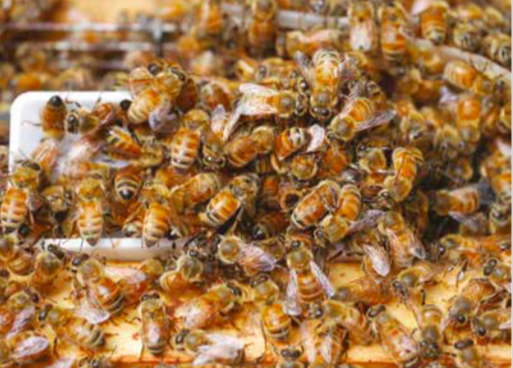
Here’s a good explanation from Maine, USA: http://mainebeekeepers.org/the-bee-line/bee-inspector-comments/ the-bee-hive-in-winter-2009-2010/
And for the more scientific explanation: http://journals.plos.org/plosone/article?id=10.1371/journal. pone.0008967
We can see the process of thermoregulation demonstrated by a cold bumble bee. On being touched, it will raise its third leg in the air and start internally vibrating its flight muscles. After a while, when its inner core and flight muscles have warmed up, the bee is able to fly. Our honey bees cannot do this individually. If a bee gets caught out overnight it requires the sun to warm it, otherwise it’s lost to the hive.
When in the winter cluster, the bees are slowly moving. The cooler ones on the outside move in to warm up and feed while those in the centre move out and cluster tightly, so very little heat is lost. On a warm day, the cluster expands and moves upwards onto another honey frame.
If you have top-bar hives, put all the honey frames in one area beside the cluster. Move a honey frame sidewards so it touches the cluster every three weeks. This will hopefully stop the bees from starving. Bees don’t naturally move sideways in winter, so you have to assist them to maintain contact with the honey frames.
Small hives often die of starvation just centimetres from frames of honey, simply because they didn’t have enough bee numbers. You can help the bees maintain a warm, dry environment by adding a sheet of insulation under the roof. We all know what a difference it makes to our houses, so why not provide a little insulation on your hives? It could also mean they consume less food in generating heat.
I live in a particularly windy part of New Zealand. Wind chill drops the air temperature considerably, so last winter a local beekeeper wrapped his hives in tarpaper. These hives came through stronger than mine in the spring. The sun’s heat raises the temperature in the hive during the day, which helps to dry out the hive and allows the bees to fly earlier. I think it also helped that he had open-mesh floors on hive stands well off the ground, meaning that there was slightly less humidity in the hives, therefore less condensation.
I was recently reading the manual for MiteGone® where the developer, Bill Ruzicka, referred to problems in using his product in New Zealand 10 or more years ago. We have higher humidity in our hives than his in British Columbia, Canada, so not enough formic acid was evaporating to provide an effective mite control. One solution was to get hives higher off the ground. Putting them on two pallets can make quite a difference in the humidity within a hive. The other was to cut the pads at a slight angle so each was evaporating six millilitres per day.
I have been observing the humidity in a couple of my hives that have Broodminder® scales and temperature- and humidity-recording devices. The humidity in the third box (five-storey hive) of the hive has been between 60% and 70% for the last two months but did go up to 80% on the nights of 24 and 25 February, while the humidity just above the brood has stayed around the 60% mark.
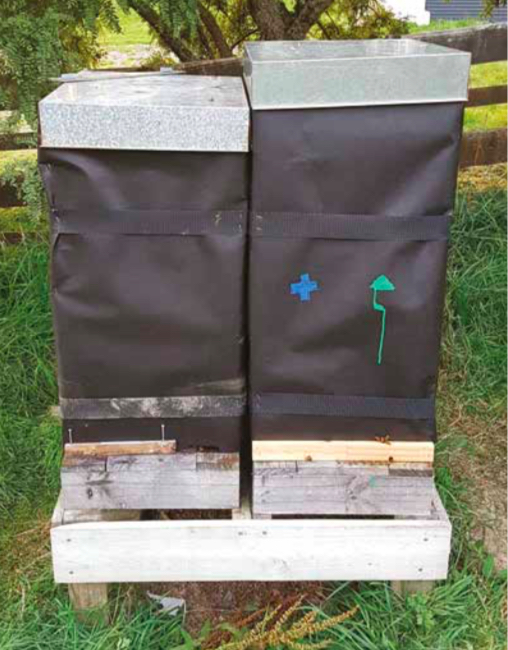
I provide a 25-mm opening in my hive mat/split board that allows moist air to escape rather than form condensation under the hive mat. Moisture dripping on bees can cause them to eat more stores during winter.
Don’t forget to check the pallet or the foundations your hive(s) sits on for rot. Replace any rotting woodware. Slope the hive forward so rain runs off the landing board and not into the hive. Reduce entrances and fit mouse guards. I also put rodent baits in a wide-neck plastic bottle under the hive, so any rodent that comes sniffing along at night feeds on these instead of trying to get into the hive. Cut the grass and clear away vegetation so hives get winter sun.
I tie my hives to the pallets with nylon cord to prevent them from being blown over in a storm and to keep the boxes together if they are knocked over by cattle. A hive on its side will continue to function if it remains intact. Some beekeepers use heavy rocks on the lids. They are free!
These are the basics for wintering. I hope I haven’t missed anything important.
Things to do this month
Remove honey if you haven’t already done so but check the brood nest for disease first. Some pōhutukawa and rata may have crystallised in the frames if it’s not off already. Giant willow aphids are still a problem in some areas. If your bees are gathering willow honeydew, start feeding sugar syrup to combat the ‘concrete honey’ (crystallised honey) problems. Bees cannot utilise willow honeydew but will survive on a willow/sugar mix.
During extraction, go through the honey supers and reject any old, dark frames you cannot see light through. Replace these with new foundation frames. Store frames with foundation or light frames on the outside with darker ones towards the middle. Freeze your stored supers to kill wax moth eggs and larvae or store them in an open, well-lit shed that provides a good airflow through the supers. (Fit queen excluders top and bottom to prevent mouse damage.)
Winter down hives. Check feed; some hives have been brooding up and could have used the honey you left on the hive. Check the effectiveness of your mite treatments with an alcohol wash. Make sure top-bar hives have 10 frames with honey in them. Feed now rather than early in the spring.
Carry out another AFB check after the robbing season has finished. There’s a lot more AFB out there mostly because there are just so many hives so close together.
Slope the hives’ bottom boards to the front so rain runs out of the hive by lifting the back of the hive up 25 mm. If you use mesh bottom boards, remove the slide and reduce the top ventilation hole as it may not be needed. Fit mouse guards or reduce entrances to 400 mm by 9 mm (just big enough to let a drone through). Replace rotten or damaged supers and bottom boards. Attend to fences, check for wasps and control grass and overgrowing shrubs.
We had a drought during December and wasp numbers have been low, so there could be a lot more Scolypopa on soft- stemmed plants this year. If you have tutu bushes within five kilometres and high passion vine hopper (Scolypopa australis) numbers, test your honey. Any honey sold or bartered has to be tested for tutin. Hobby clubs can have their members’ samples composite tested to save money. Check the tutin regulations on the MPI website. Once you have established through testing that you do not have a tutin problem, the number of tests required is reduced.
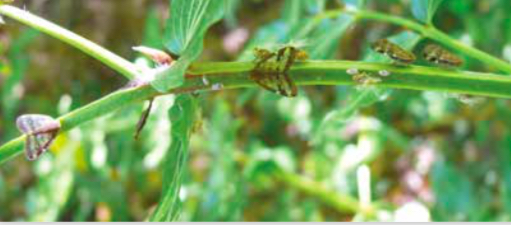
Frank Lindsay